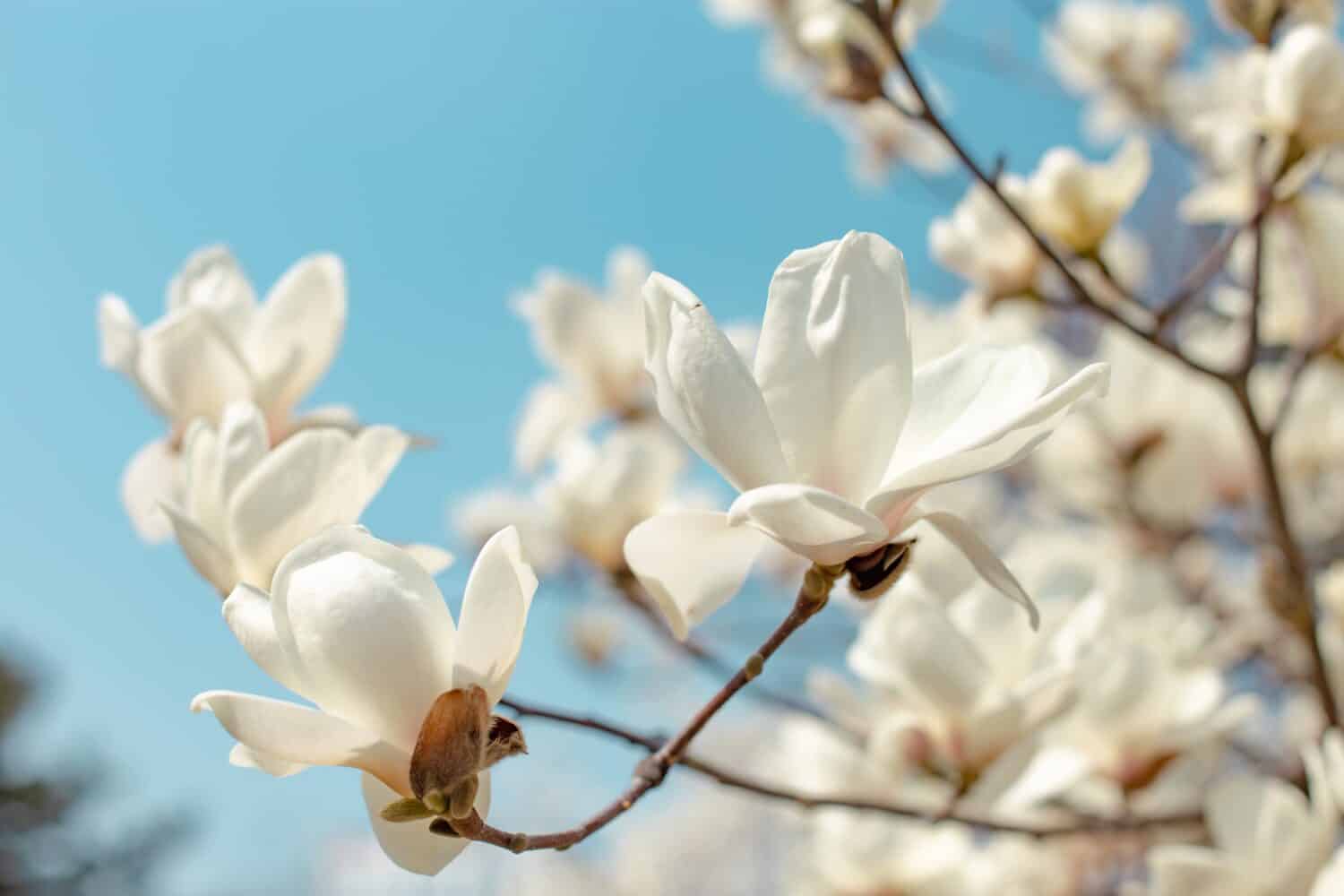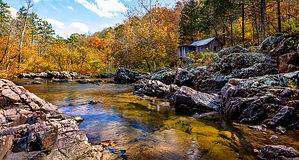Georgia’s diverse climate zones create an ideal environment for flowering trees to flourish. From the serene beauty of dogwoods to the elegance of magnolias, various flowering trees embellish Georgia’s landscapes. From all the flowering trees, here are the 22 best that grow in the Peach State.
1. Flowering Dogwood (Cornus florida)
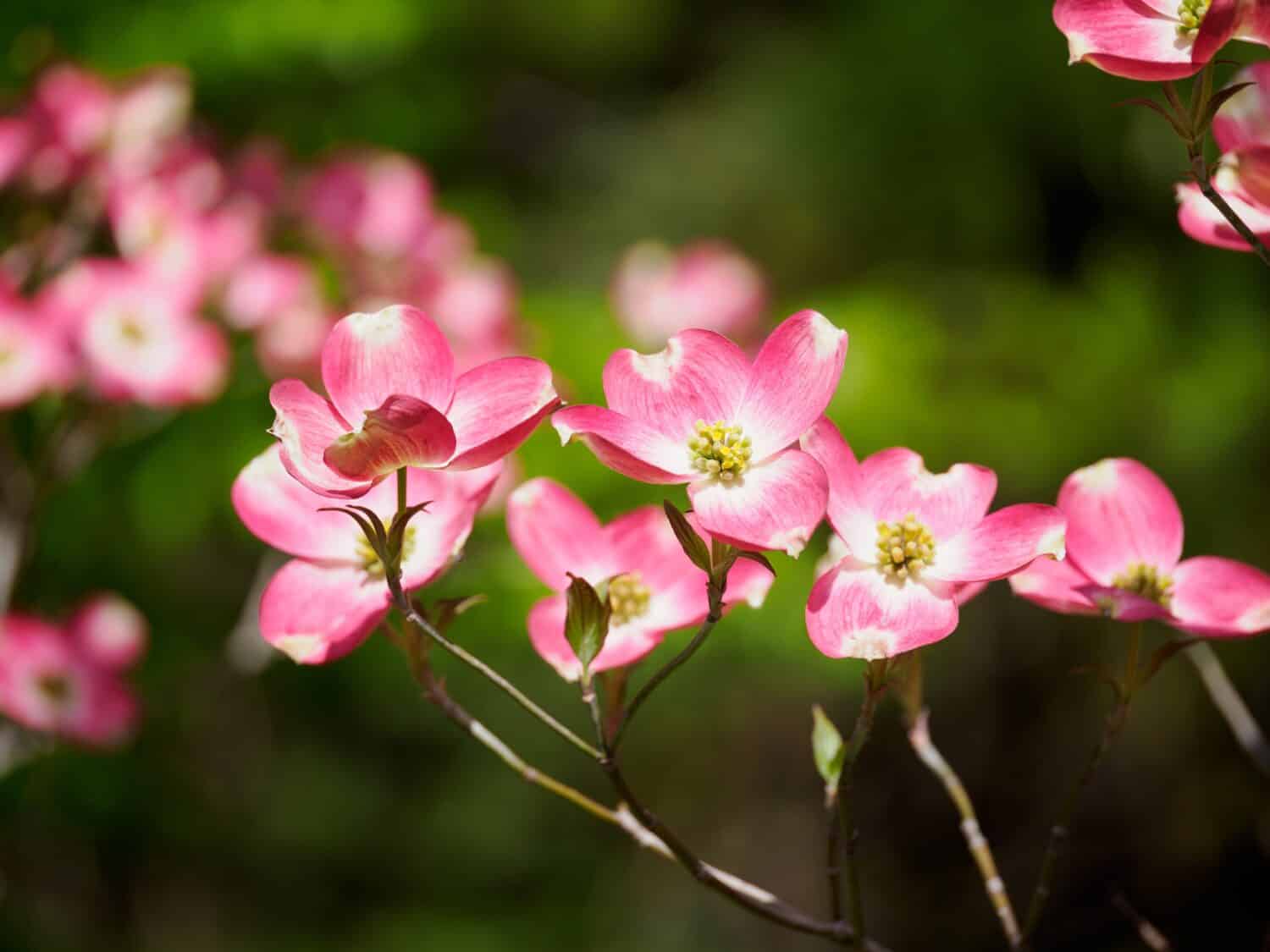
The flowering dogwood is named for its showy spring flowers and a colonial description of not being edible for a dog.
©F_studio/Shutterstock.com
If you visit Georgia, you might encounter a lot of flowering dogwood. This tree is one of Georgia’s most beloved and iconic flowering trees. It also holds cultural significance, often associated with rebirth and renewal due to its annual blossoming cycle.
The dogwood displays stunning white, pink, or even red flowers in the early spring with its four-petaled blossoms. In the fall, the green leaves transform into shades of deep red.
Native to eastern North America, this tree thrives in well-drained, slightly acidic soils and partial shade. Low maintenance, the flowering dogwood only requires watering during dry spells.
2. Cherry Blossom (Prunus serrulata)
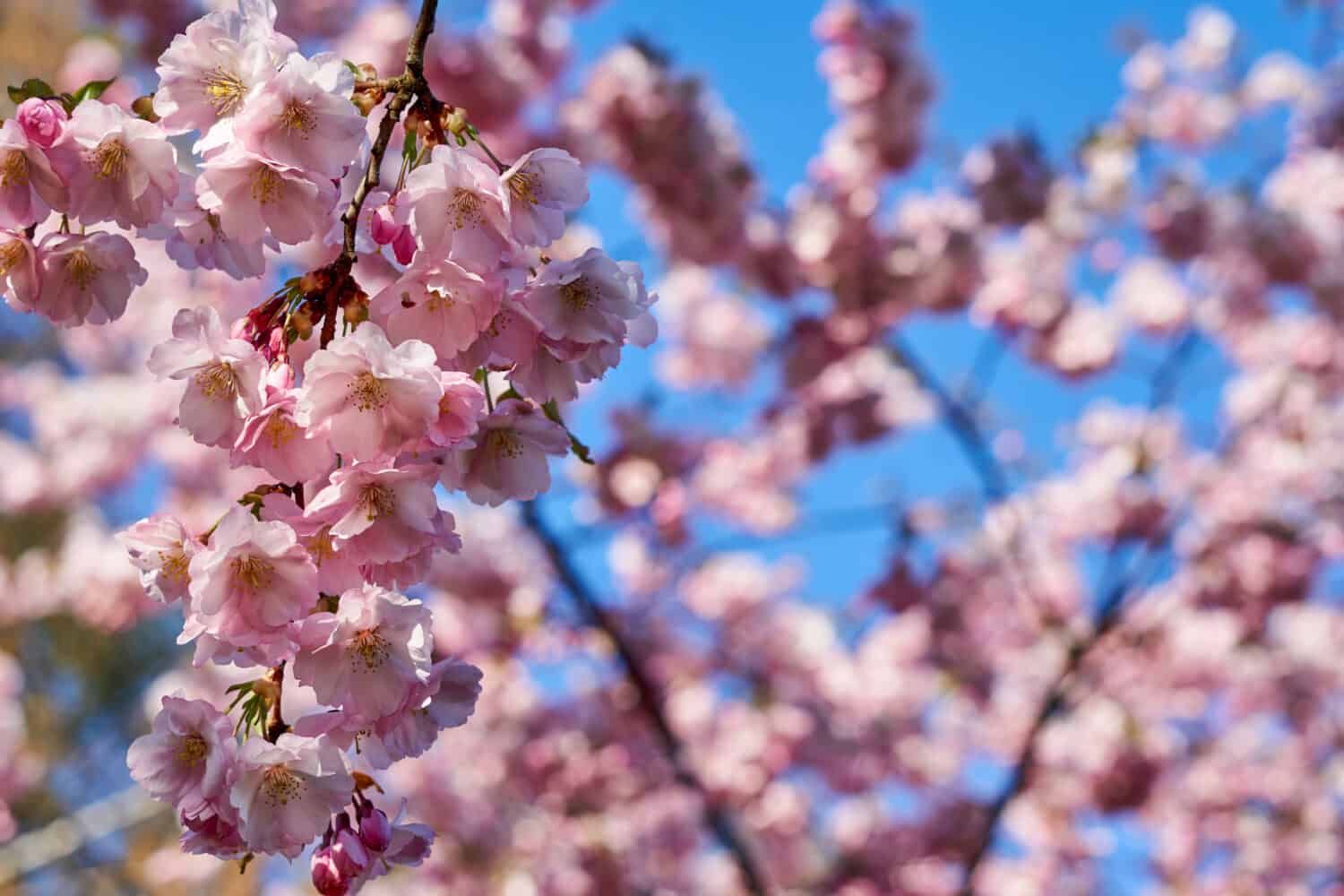
The cherry blossom is considered the national flower of Japan.
©nadia_if/Shutterstock.com
The cherry blossom, though deeply associated with Japanese culture, is also captivating in Georgia’s landscapes. These exquisite trees, often called “sakura,” have stunning ephemeral displays of soft pink and white petals.
As temperatures warm, cherry blossoms unfurl their flowers every spring, transforming parks, gardens, and streets into ethereal realms of color. Its popularity has led to its widespread cultivation across the state.
The annual Cherry Blossom Festival in Macon, GA, celebrates the splendor of these trees and brings communities together.
3. Southern Magnolia (Magnolia grandiflora)
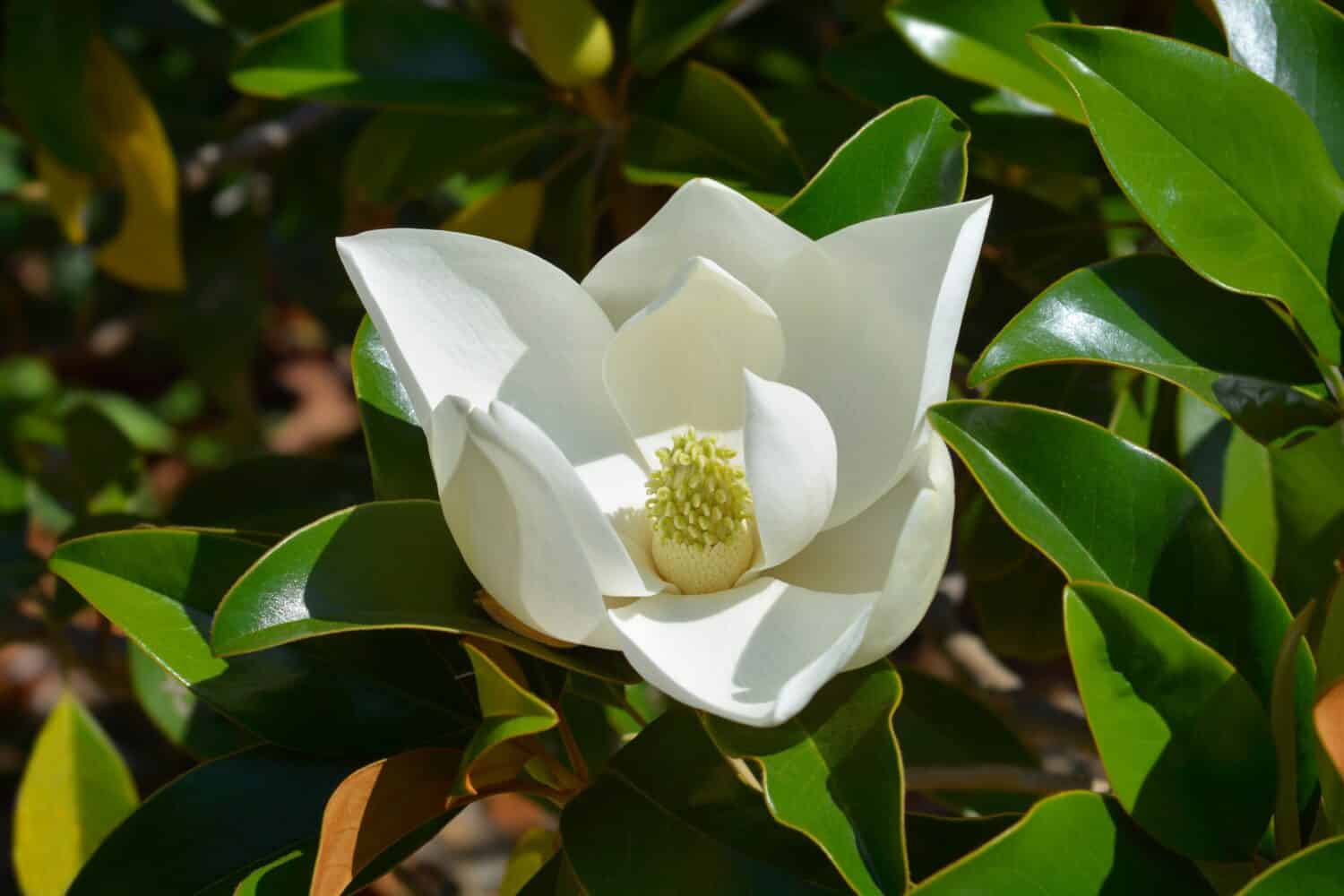
The southern magnolia is one of the most famous trees in the South of the United States.
©Nahhana/Shutterstock.com
The magnolia is an iconic symbol of the American South. This ancient genus comprises various species with distinct characteristics, but all share a common thread of elegance and splendor. The southern magnolia stands out as an emblem of the region, with its large, glossy leaves and colossal white flowers that emit a subtle, sweet fragrance.
Magnolias have a unique and ancient history; they are one of the most primitive plants in evolutionary history. Fossil records show that magnolias once existed in Europe, North America, and Asia more than 100 million years ago. Today, these majestic trees thrive in Georgia’s temperate climate, adorning gardens, parks, and streets.
Beyond the southern magnolia, other varieties like the sweetbay magnolia thrive in Georgia.
4. Azaleas (Rhododendrom spp.)
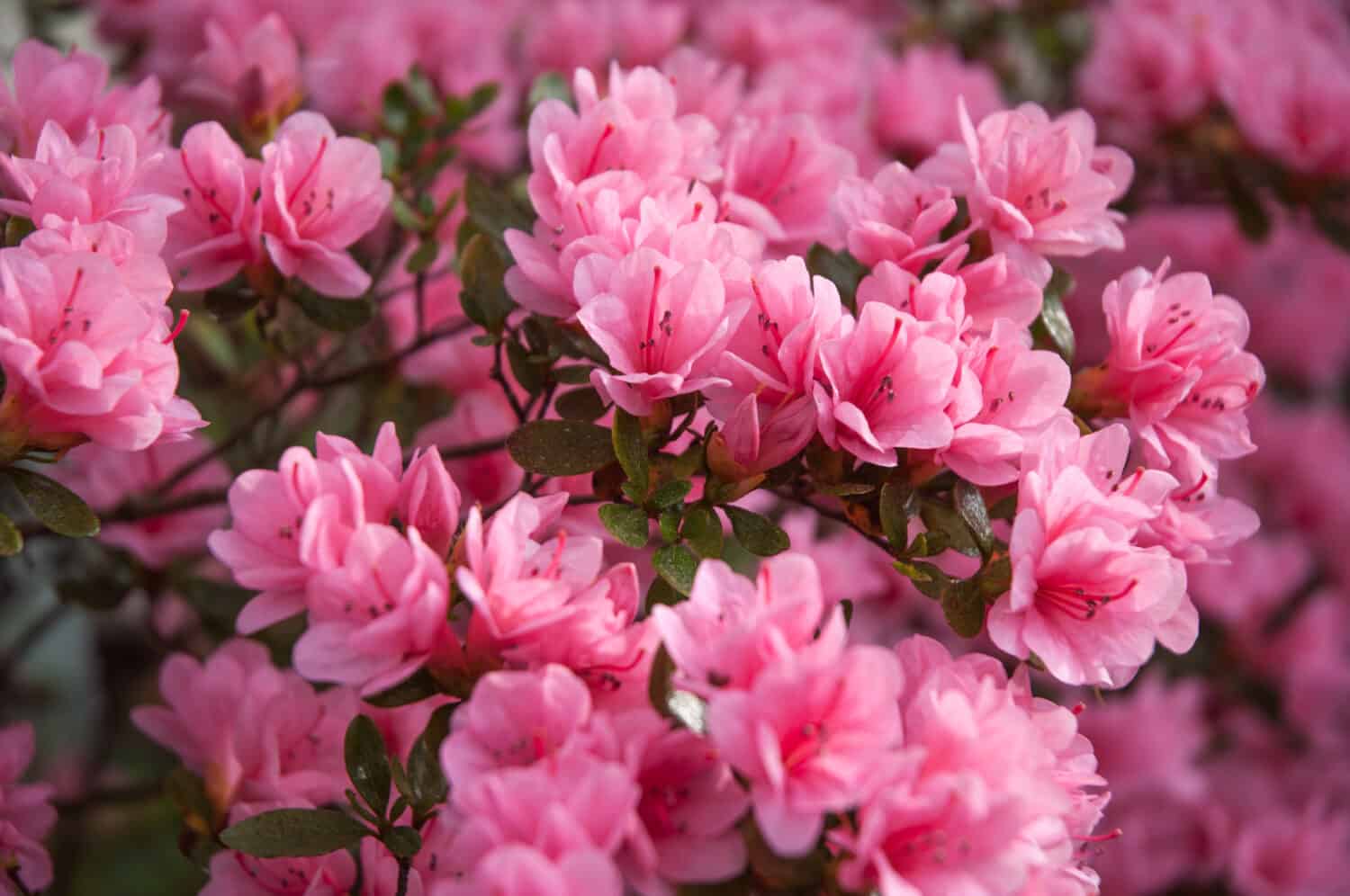
The piedmont azalea is native to Georgia.
©PatGallery/Shutterstock.com
With their vibrant colors, azaleas are some of the most stunning flowering trees. These thrive in the state’s temperate climate and the acidic soils of pine forests and gardens. Georgia has its own native azalea — the piedmont azalea.
With their impressive array of hues, including shades of pink, purple, red, and white, azaleas create a dazzling spectacle in spring. Their unique trumpet-shaped blooms cluster in dense profusion, adding to the beauty.
Cultivating azaleas requires understanding their unique needs, with well-drained soils and extensive moisture. If they start as flower shrubs, with patience and a lot of maintenance, they can become stunning trees.
5. Sweet Crabapple (Malus coronaria)

The sweet crabapple is prone to diseases and pests.
©John A. Anderson/Shutterstock.com
The sweet crabapple is deeply rooted in the state’s natural landscapes. This small tree, adorned with showy blossoms, attracts pollinator species and plays a crucial role in the local ecosystems.
Its delicate pink-to-white flowers emerge in spring, adding beauty to woodlands, meadows, and urban environments. Beyond its flowers, the native crabapple’s small, apple-like fruit is a vital food source for various wildlife, from birds to deer.
Sweet crabapples have adapted to Georgia’s climate, thriving in various soil types and light conditions. Their resilience, coupled with their pollination importance, makes them a valuable addition to conservation efforts.
6. Redbud Tree (Cercis canadensis)
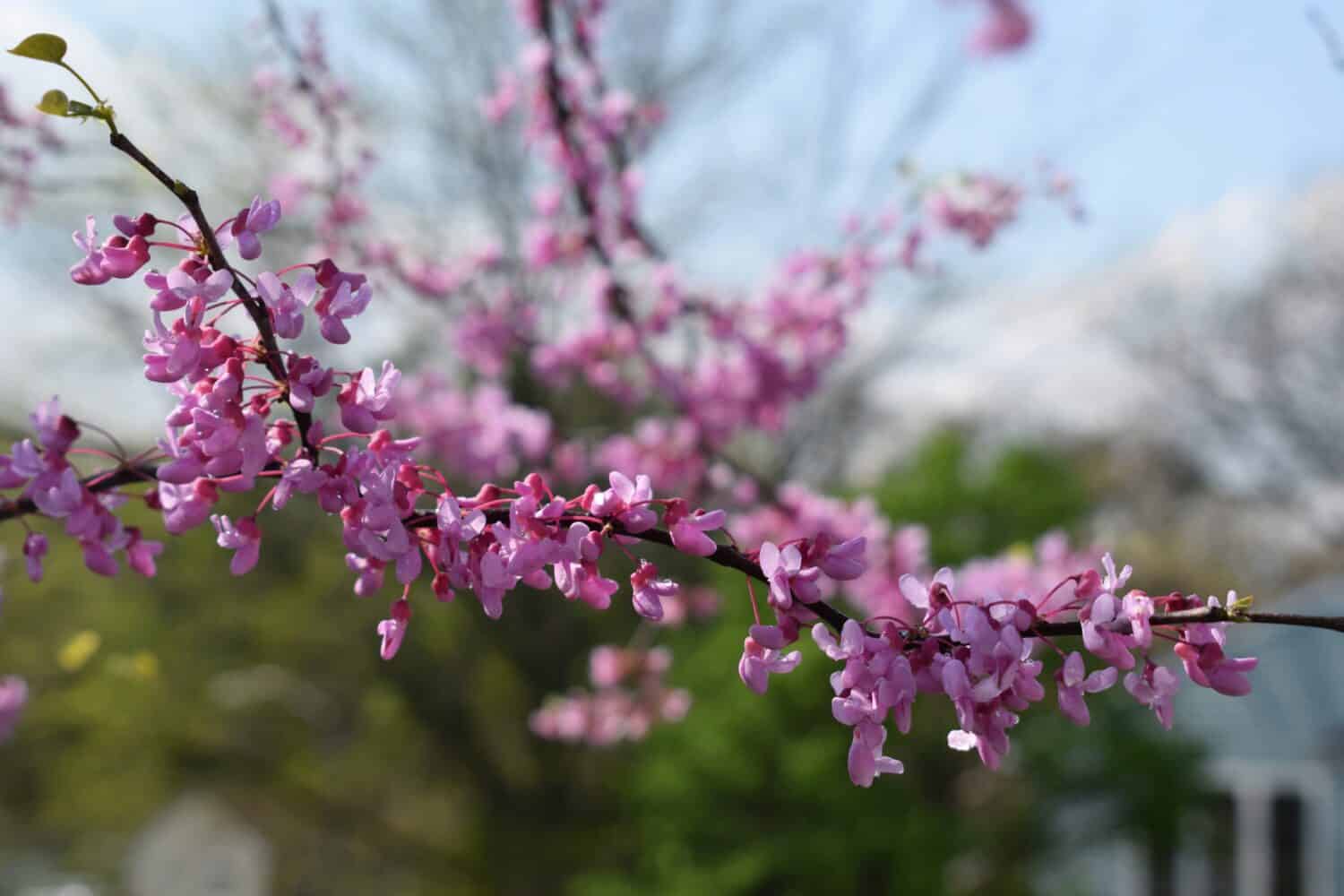
The redbud trees generally grow with a divided trunk close to the ground.
©Marsha88/Shutterstock.com
Native to Georgia and other states, the redbud tree paints the landscape with its breathtaking display of vibrant pink to lavender blossoms. This tree has a profusion of delicate, pea-like flowers that emerge along its branches in early spring. Also, its heart-shaped leaves transition from a reddish hue in spring to deep green in summer and warm shades of yellow in the fall.
Often used as a specimen tree, a redbud can also be planted in groups to create a woodland. Its small stature and manageable growth also make it suitable for smaller spaces. Additionally, the redbud tree plays a vital role in supporting local wildlife by providing nectar for pollinators and its seeds for birds and other animals.
7. Crape Myrtle (Lagerstroemia indica)
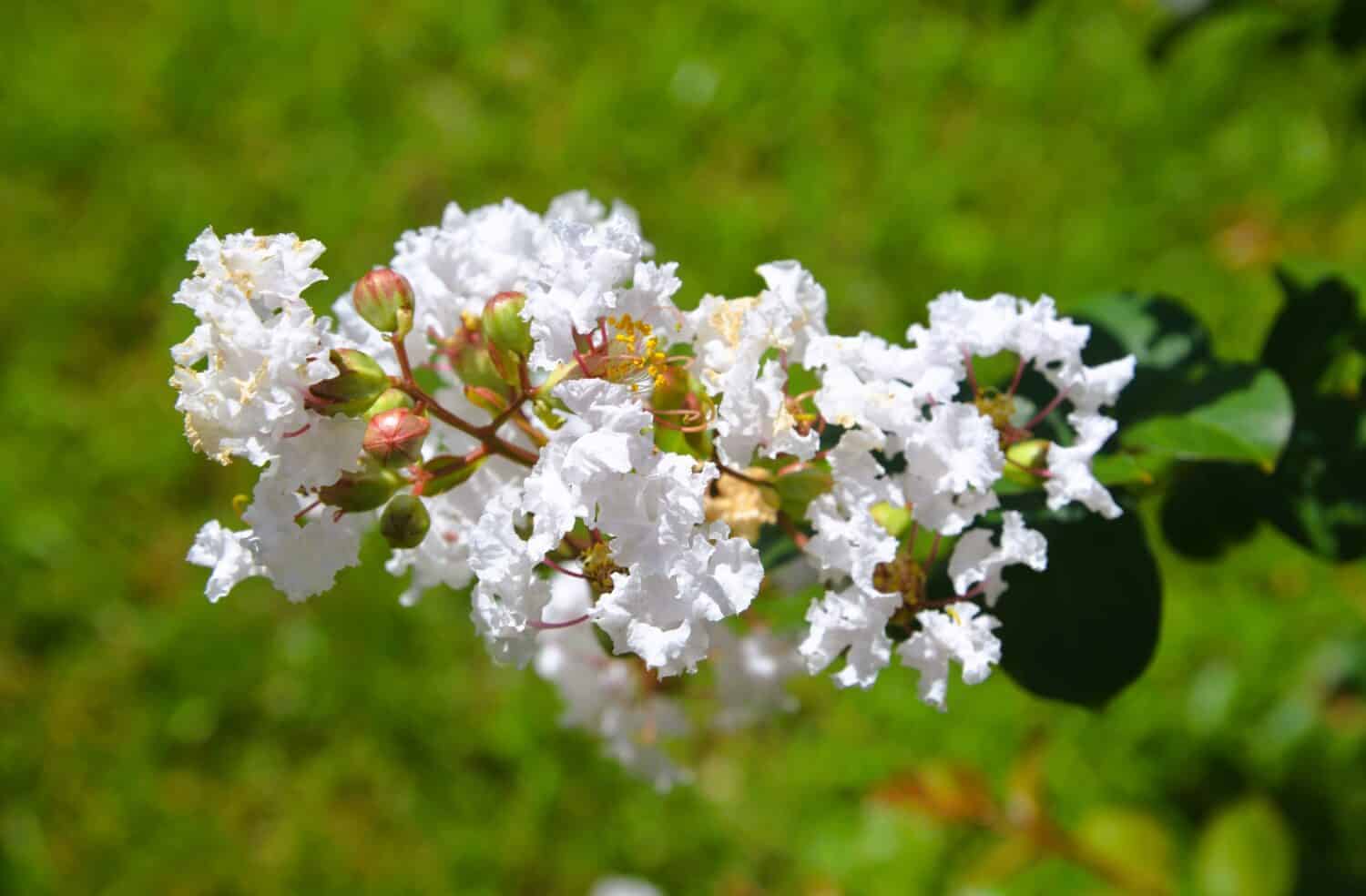
The crape myrtle is native to the Indian subcontinent, China, and Korea.
©Shelia R. Wiseman/Shutterstock.com
With its show-stopping summer blossoms and vibrant foliage, the crape myrtle is a famous tree in Georgia. Renowned for its ability to thrive in the hot and humid climate, it bursts into bloom during the warmer months, with flowers in hues ranging from pure white to deep crimson.
The crape myrtle’s exceptional drought tolerance, pests, and disease resistance make it a low-maintenance choice that can thrive with minimal care.
8. Sweet Bay Magnolia (Magnolia virginiana)
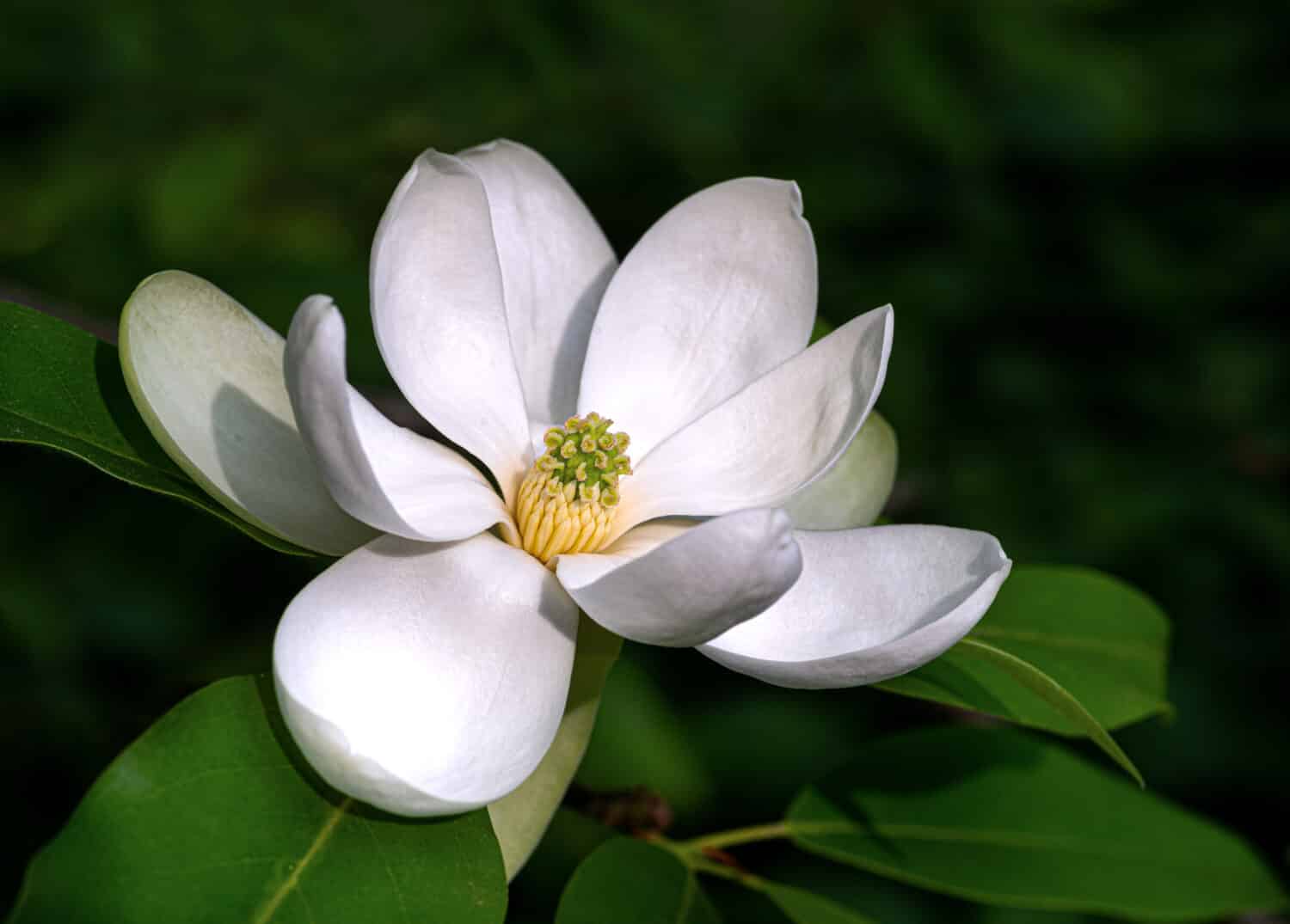
The sweet bay magnolia is one of 80 varieties of magnolia.
©Gerry Bishop/Shutterstock.com
The sweet bay magnolia, native to the southeastern United States, brings its elegant presence and sweet fragrance to Georgia’s landscapes.
With its glossy green leaves, the sweet bay magnolia is an evergreen to semi-evergreen tree. But its most iconic feature is its creamy-white, fragrant flowers, which emerge in late spring. These blossoms attract pollinators and infuse the air with a delightful citrus-like fragrance.
This majestic tree is suited to a variety of environments, in wetlands, along the edges of ponds, and in slightly acidic, well-drained soils. With its adaptability and tolerance to both sun and partial shade, this tree is a versatile addition to landscapes across Georgia. Besides its stunning beauty, the sweet bay magnolia also holds cultural significance, having been used for its medicinal properties by indigenous peoples and early settlers.
9. Scarlet Buckeye (Aesculus pavia)
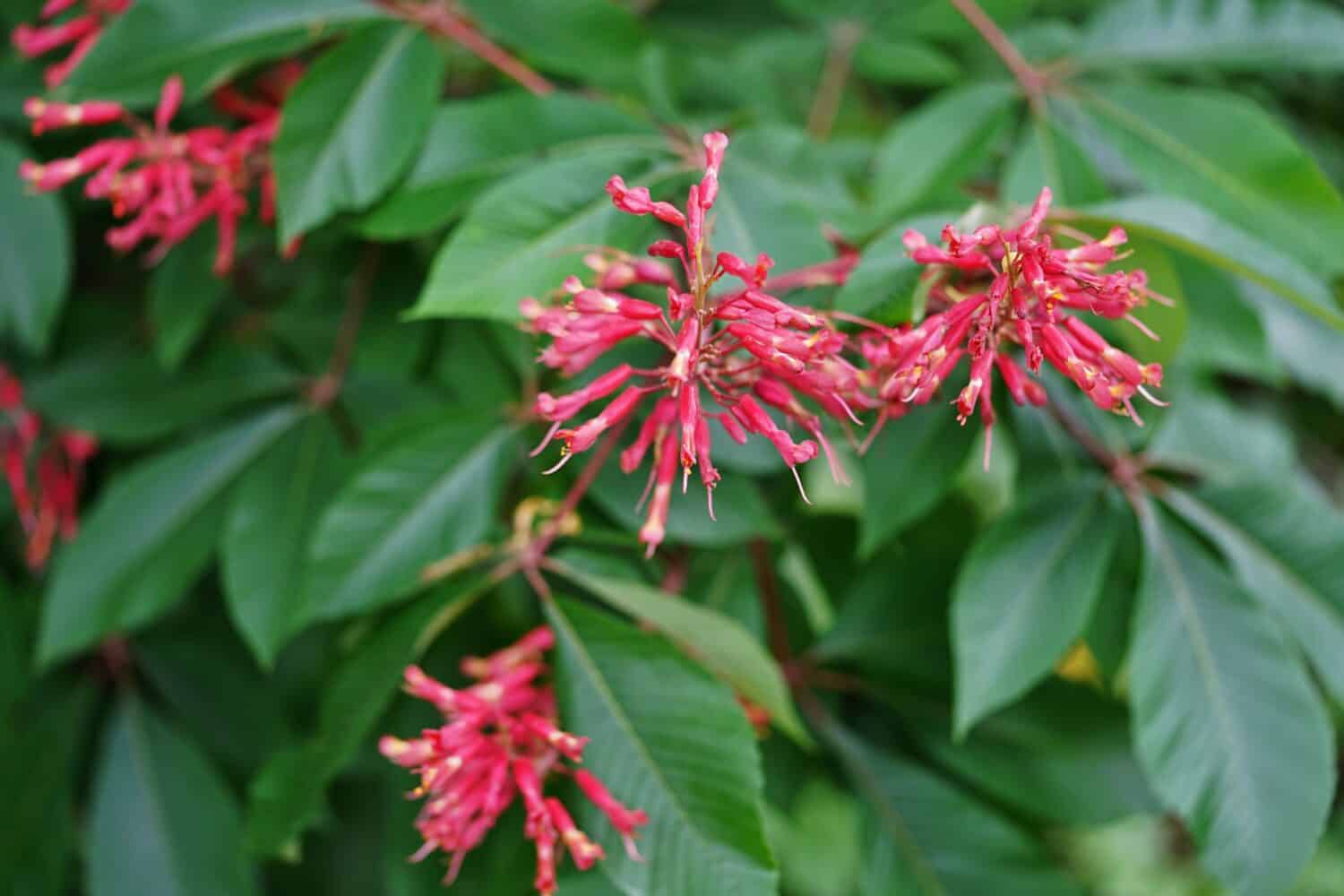
The scarlet buckeye’s vibrant red blooms attract pollinators in early spring.
©EQRoy/Shutterstock.com
The scarlet buckeye, native to the southeastern United States, including Georgia, is a vibrant addition to the state’s flora. This deciduous shrub or small tree earns its name from the striking clusters of bright red tubular flowers that adorn its branches in early spring.
The tree’s fiery blooms often attract hummingbirds and pollinators. As the season progresses, the scarlet buckeye transitions from emerging green leaves to palmate leaves that provide dappled shade.
With their ability to adapt to various soil types and shade tolerance, scarlet buckeyes are well-suited for wooded areas or gardens.
10. Smoke Bush Tree (Cotinus coggygria)
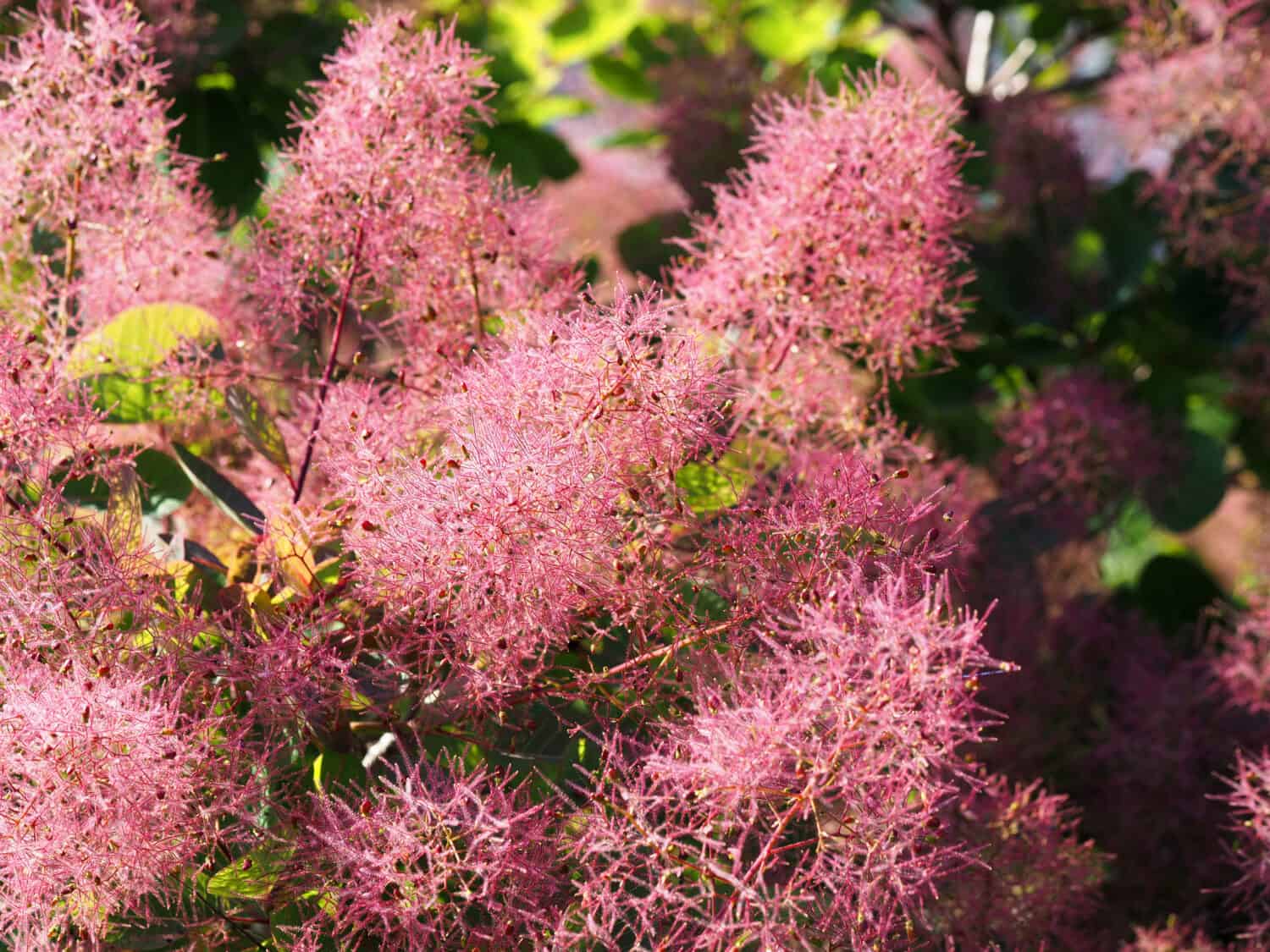
Flower filaments give the smoke tree a unique appearance.
©ANGHI/Shutterstock.com
The smoke bush tree, also known as the smoke tree or smokebush, is characterized by its feathery inflorescences that resemble clouds of smoke, hence its intriguing name.
The flowers range in color from soft pink to smoky purple. As the blooms transition, they give way to foliage that transforms from shades of deep maroon in spring to purples, reds, and oranges in the fall.
Native to Southern Europe and parts of Asia, the smoke bush tree adapts well to Georgia’s climate and thrives in well-drained soils with full sun to partial shade. With its low-maintenance nature, this small tree makes it an attractive option for those seeking a tree that delivers both beauty and ease.
11. American Fringe Tree (Chionanthus virginicus)
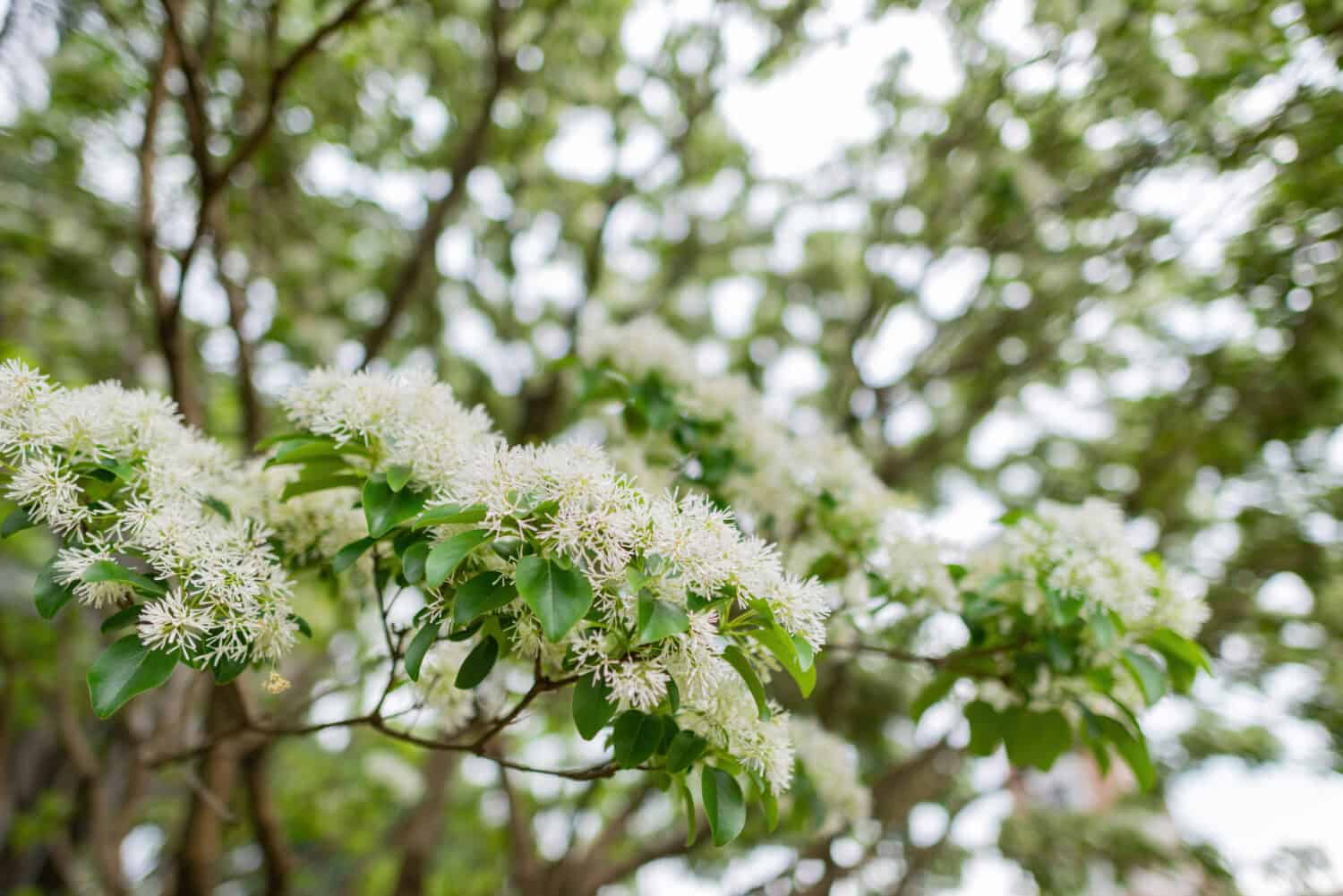
The American fringe tree is native to the savannas and lowlands of the northeastern and southeastern United States.
©Kit Leong/Shutterstock.com
Also known as Grancy Gray Beard, this deciduous tree showcases a profusion of fragrant, white, fringe-like flowers cascading from the branches in late spring. Beyond its flowering period, its dark green leaves turn vibrant shades of yellow in the fall.
Native to the southeastern United States, the American fringe tree thrives in well-drained soils and can adapt to full and partial shade. Also, the tree’s blue-black fruits attract various birds, adding an ecological dimension to its appeal.
12. Chaste Tree (Vitex agnus-castus)

Chaste tree has been used to treat menstrual cycle problems and pain, and menopause.
©Wut_Moppie/Shutterstock.com
The chaste tree, also known as monk’s pepper or simply vitex, brings its feathery, aromatic blooms to Georgia’s landscape. Its history traces back to ancient times when monks used it to temper desires – hence its name.
Native to the Mediterranean region, this deciduous shrub showcases elongated spikes of fragrant flowers that range from shades of lavender to soft blue.
Blooming in late spring and continuing through summer, the chaste tree attracts a variety of pollinators, making it a valuable asset to local ecosystems. The chaste tree is drought-tolerant, thrives in well-drained soils, and can adapt to various conditions. It is ideal for gardeners seeking a resilient, low-maintenance, and flowering tree.
13. Carolina Silverbell (Halesia carolina)
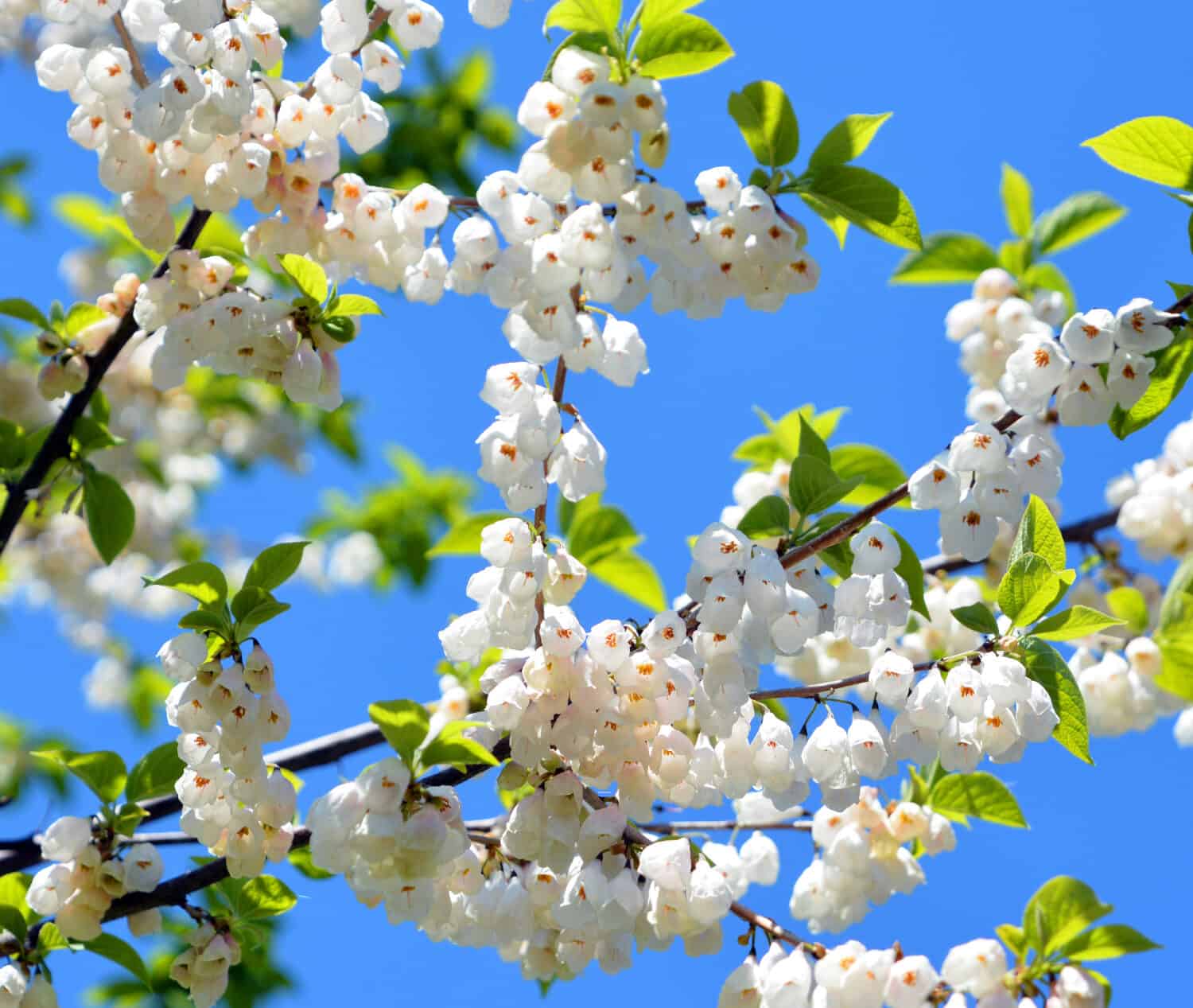
The Carolina silverbell’s name is derived from the flowers that resemble small silver bells.
©meunierd/Shutterstock.com
Native to the southeastern United States, including Georgia, this small to medium-sized deciduous tree boasts pendulous clusters of bell-shaped flowers. In early spring, the blossoms, ranging from creamy white to soft pink, seem to transform the tree into a cascading fountain of blooms.
When the flowers fade, heart-shaped leaves emerge, creating a lush canopy that provides shade during the warmer months. This small tree thrives in well-drained, moist soils and partial shade and adapts well to the humid climate of Georgia.
14. Flowering Peach ‘Corinthian Rose’ (Prunus persica ‘Corinthian Rose’)

This peach tree displays stunning flowers before ripening for fruits.
©jessicahyde/Shutterstock.com
Georgia is also called the Peach State, thanks to its production of Georgia peaches, known for their superior taste, appearance, and all-around quality. Before producing tasty summer fruits, peach trees display beautiful and delicate flowers.
The flowering peach tree bursts into a profusion of pink flowers that cover its branches during spring, symbolizing the arrival of warmer days. As the seasons change, its glossy green foliage transforms into shades of orange, red, and purple in the fall, offering a multi-seasonal display of color. ‘Corinthian Rose’ stands out not only for its showy-pink blooms but also for its moderate size.
Ideally suited to Georgia’s temperate climate, this tree flourishes in full sun and well-drained soil. Low-maintenance, it is an ideal flowering tree for novice and experienced gardeners. Plus, as the tree will display beautiful flowers throughout the year, it will also offer delicious and juicy peaches.
15. Flowering Plum (Prunus spp.)

Flowering plums are also fruit trees for various varieties of plums.
©Akif CUBUK/Shutterstock.com
The flowering plum displays a burst of early spring color with its charming and vibrant blossoms. Various species and cultivars of flowering plums exist. But they all have a profusion of delicate, pink-to-white flowers, which emerge before the tree’s leaves. In the warmer months, the leaves transform from reddish to purple.
Adaptable to Georgia’s climate, the flowering plum prefers full sun and well-drained soil, ensuring its optimal growth and bloom performance. These trees are relatively short-lived and can be susceptible to disease or pest issues in certain conditions. Regular maintenance, including pruning and proper care, ensures the tree’s health and longevity.
16. Raspberry Smoothie Rose of Sharon (Hibiscus syriacus ‘Raspberry Smoothie’)
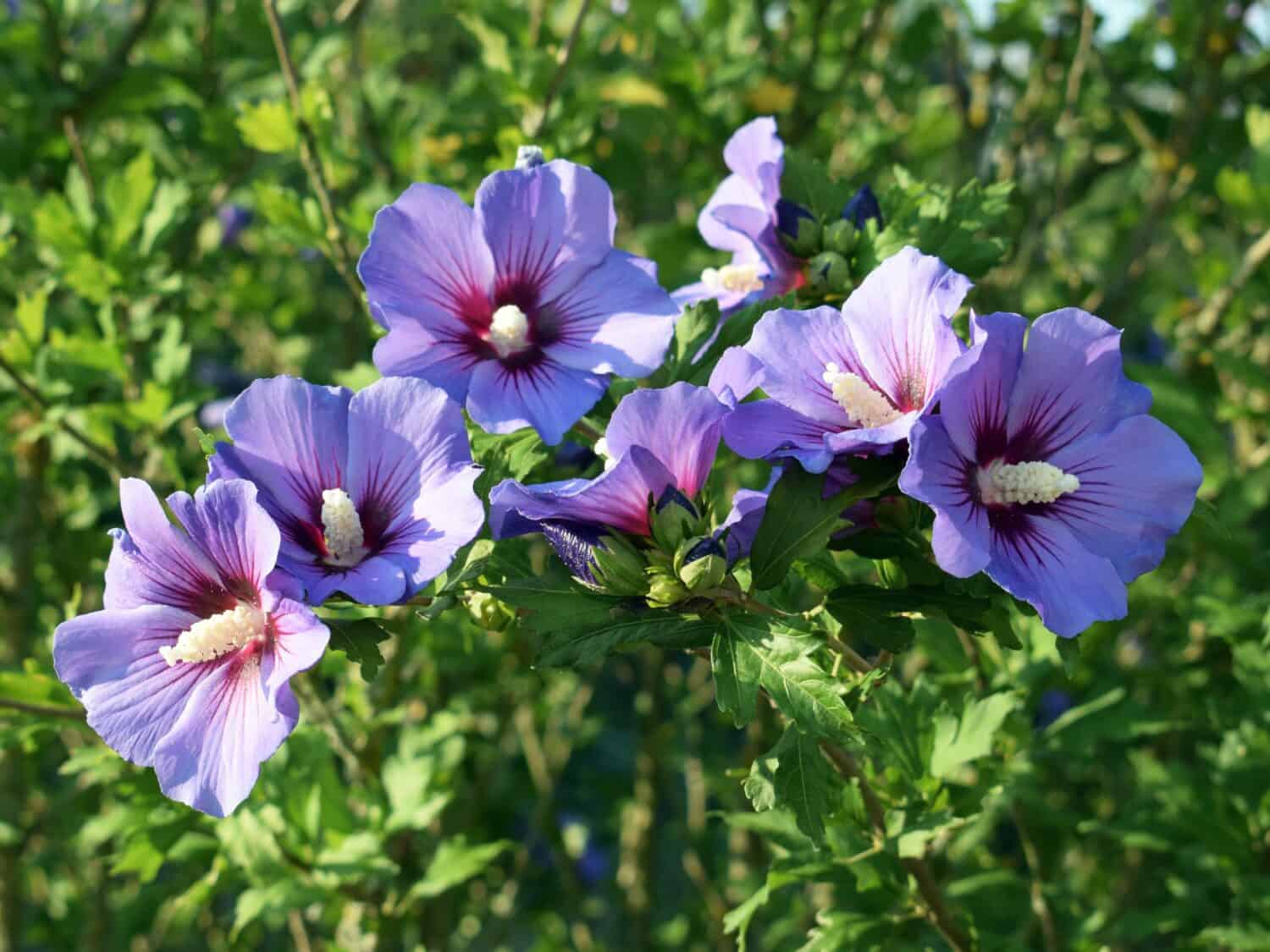
This stunning shrub is resistant to diseases, pests, and also deer.
©matunka/Shutterstock.com
Characterized by its robust growth and eye-catching blooms, this deciduous shrub offers a refreshing twist on the traditional rose of Sharon. The ‘Raspberry Smoothie’ variety boasts large, ruffled flowers in shades of vibrant raspberry pink that bloom profusely in the heat of summer. These showy flowers attract dozens of pollinators, adding life and vitality to outdoor spaces.
Thriving in full sun and well-drained soil, this hibiscus species is well-suited for Georgia’s climate. If it initially grows as a shrub, experienced gardeners, with time and care, can transform it into a small-sized tree.
17. Tulip Poplar (Liriodendron tulipifera)
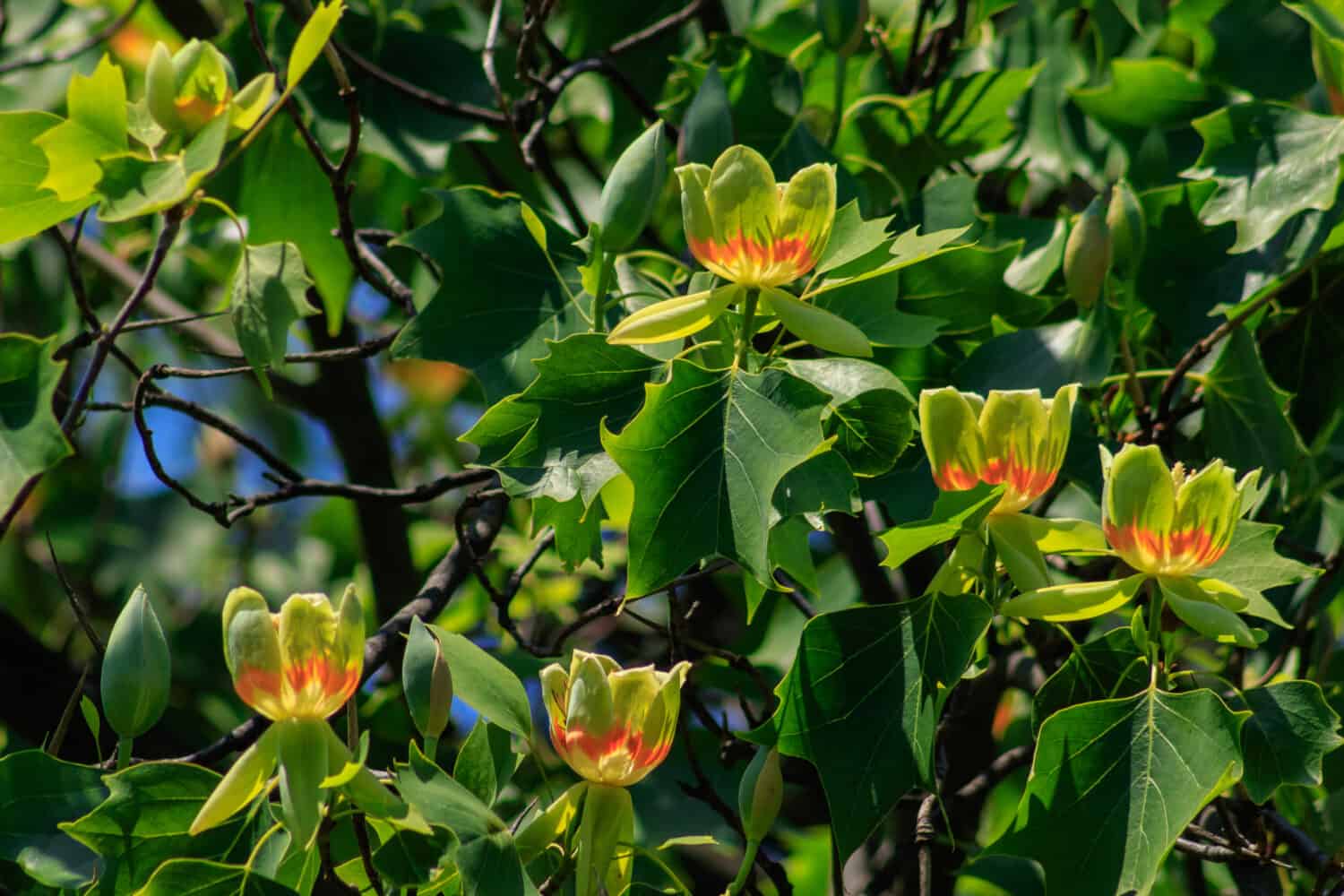
The tulip poplar can reach 300 years of age.
©Yanosh Nemesh/Shutterstock.com
The tulip poplar, also known as the tulip tree or yellow poplar, draws attention with its towering stature, striking foliage, and unique flowers. Despite its name, the tulip poplar is not a poplar tree but rather a member of the magnolia family.
Its distinct leaves, which resemble the outline of tulip flowers, hence its name, contribute to its iconic appearance. In late spring to early summer, the tree produces greenish-yellow cup-shaped flowers with orange markings. These vibrant blossoms are crucial to the ecosystem as they serve as a beacon for pollinators. In the fall, the leaves transform into a brilliant golden-yellow color.
The tulip poplar thrives in Georgia and appreciates full sun to partial shade. Its rapid growth allows it to reach towering heights, often 70 to 90 feet, in a relatively short span. The tallest trees of this species can reach up to 130 feet.
The tree’s lumber has been historically used for various applications, from furniture to cabinetry.
18. Serviceberry (Amelanchier spp.)

This tree berry is full of flavor and makes up a healthy snack.
©Korostylev Dmitrii/Shutterstock.com
The serviceberry, also known as juneberry or shadbush, graces Georgia’s landscapes with its delicate blossoms and tasty fruit. Its white or pink flowers in early spring provide early-season nectar for pollinators. As the seasons advance, the serviceberry produces edible berries that ripen in early summer. Those attract birds and wildlife but also offer a delightful treat for humans.
Well suited to Georgia’s climate, the serviceberry prefers well-drained soil and can tolerate both sun and partial shade. With its adaptability and low maintenance, it is an excellent choice for a variety of gardens. Plus, the berries can be eaten as snacks or used in jams, pies, and other culinary creations.
19. American Yellowwood (Cladrastis kentukea)
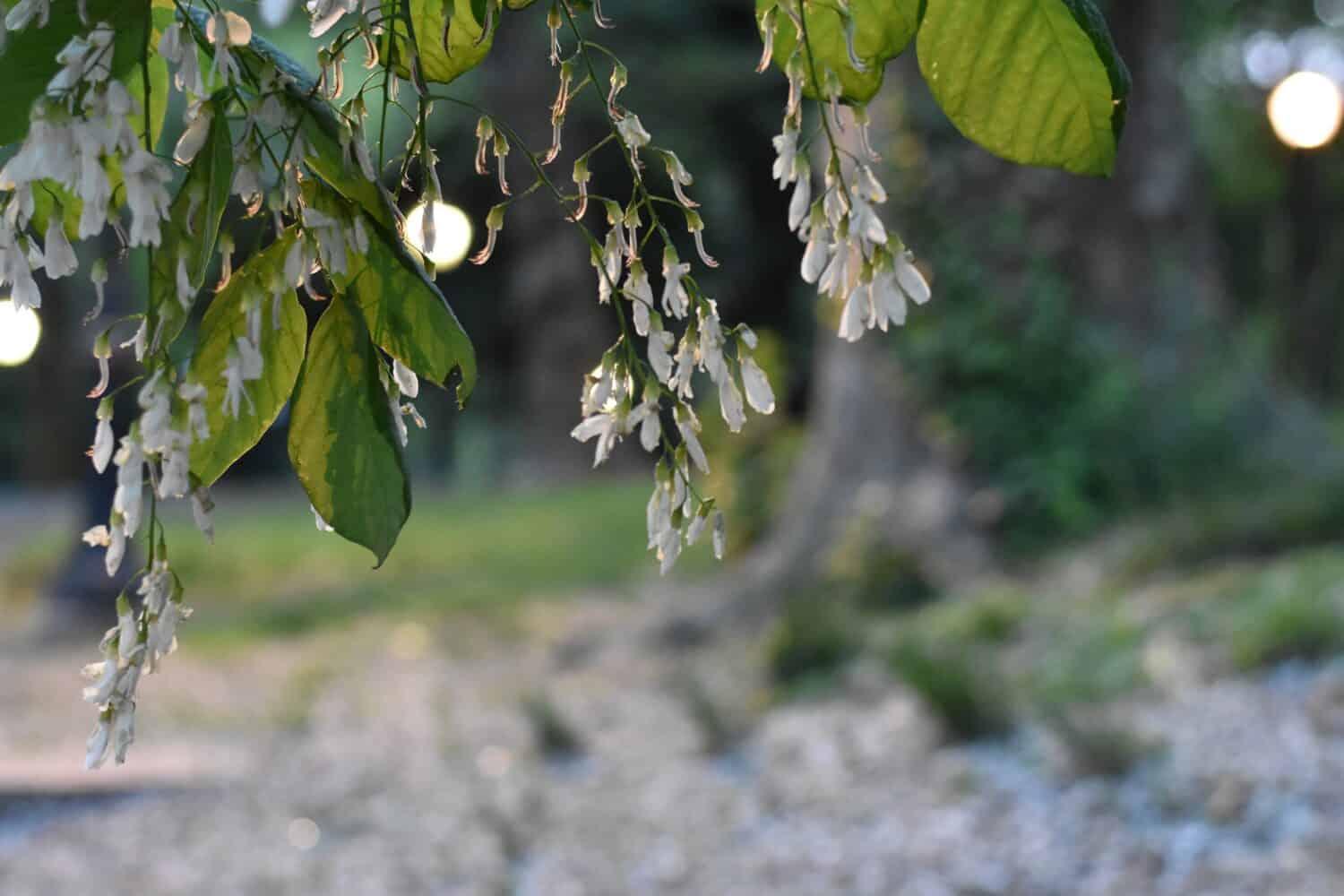
The American yellowwood gets its name from its yellow leaves in the fall.
©Angela Feltes/Shutterstock.com
The American yellowwood is a splendid native tree of the southeastern United States. This tree holds a unique conservation story, as it was once believed to be extinct but was later rediscovered in the wild.
In late spring or early summer, the tree’s white flowers create an enchanting waterfall effect, infusing the surroundings with a sweet and delicate fragrance. As the seasons progress, the tree’s pinnate leaves turn into vibrant shades of yellow in the fall.
Native to the state, the American yellowwood perfectly suits Georgia’s climate. This tree’s ecological value is also significant, as its nectar-rich blossoms attract pollinators, contributing to the health and diversity of local ecosystems.
20. Purple Robe Locust Tree (Robinia pseudoacacia ‘Purple Robe’)
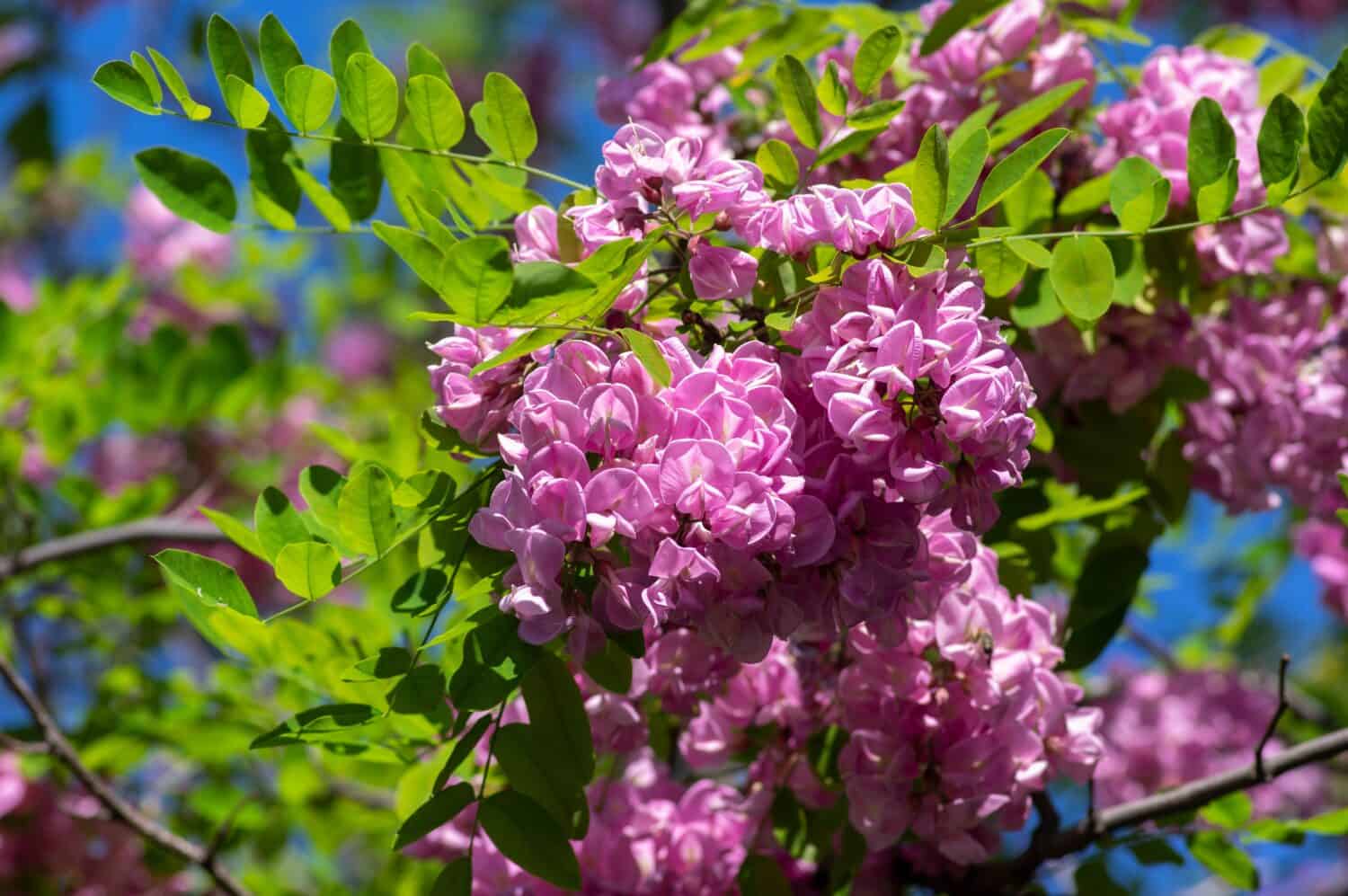
The purple robe locust tree’s bark, leaves, and seeds are poisonous if eaten.
©Iva Vagnerova/Shutterstock.com
The purple robe locust tree has a unique appearance. This deciduous tree showcases cascades of fragrant, pea-like flowers that drape from its branches in late spring to early summer. These blossoms range from magenta to deep purple.
Adapted to the southeastern United States, the purple robe locust tree prefers full sun and well-drained soil, enhancing its growth and flowering potential. Historically, this tree’s wood has been used for fence posts and other practical applications.
21. Limelight Hardy Hydrangea Tea (Hydrangea paniculata ‘Limelight’)
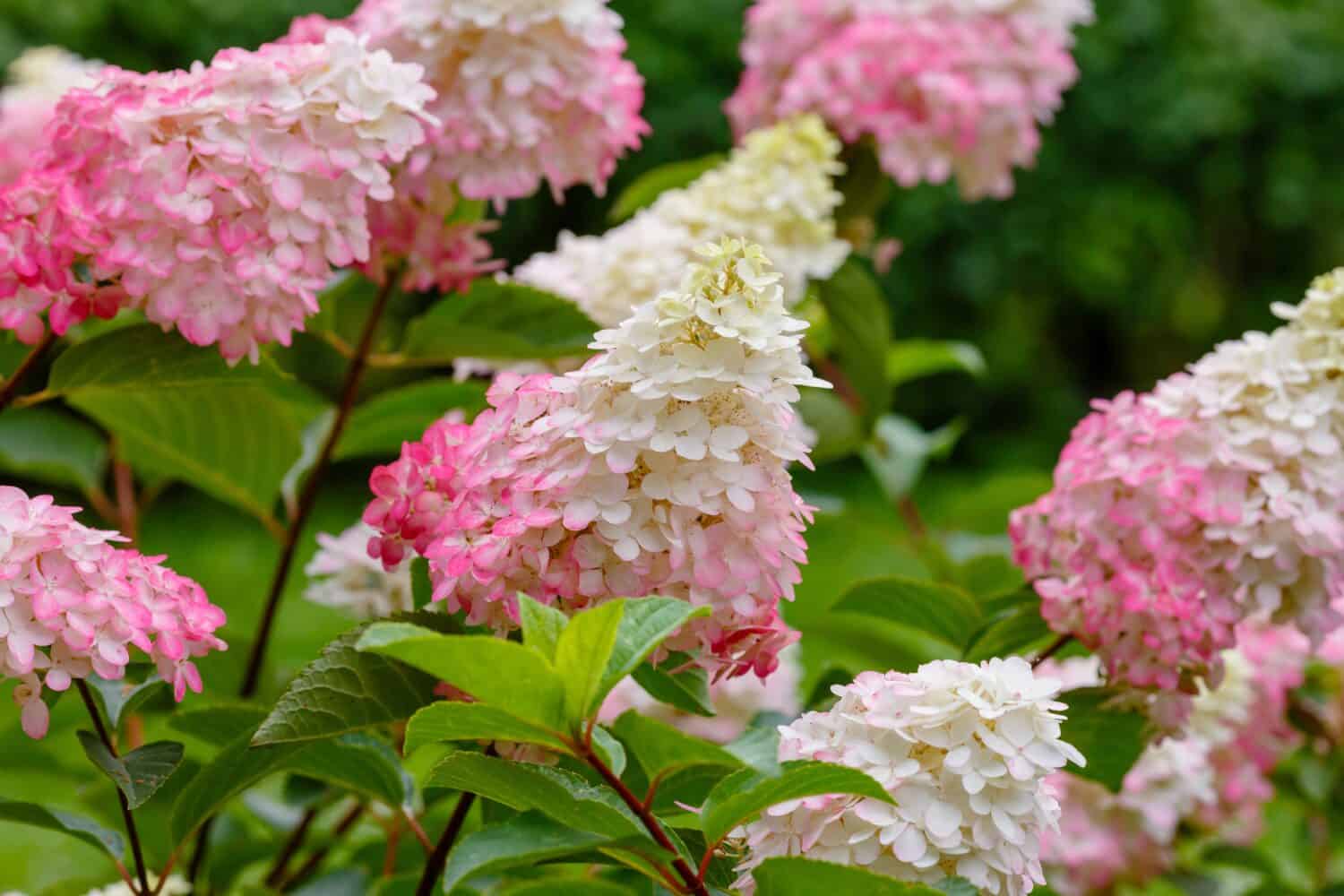
Hydrangeas are not edible and are poisonous to cats, dogs, and horses.
©Flower_Garden/Shutterstock.com
This deciduous shrub stands out for its large, cone-shaped flower clusters that emerge in midsummer. In the summer months, they transform from creamy white to lime green and shades of pink as fall approaches.
Its upright growth habit and strong stems ensure that the large flower heads remain upright. Thriving in both full sun and partial shade, this tree also adapts well to Georgia’s climate. It is the perfect tree for homeowners looking to enjoy stunning blossoms.
22. Witch Hazel Tree (Hamamelis virginiana)
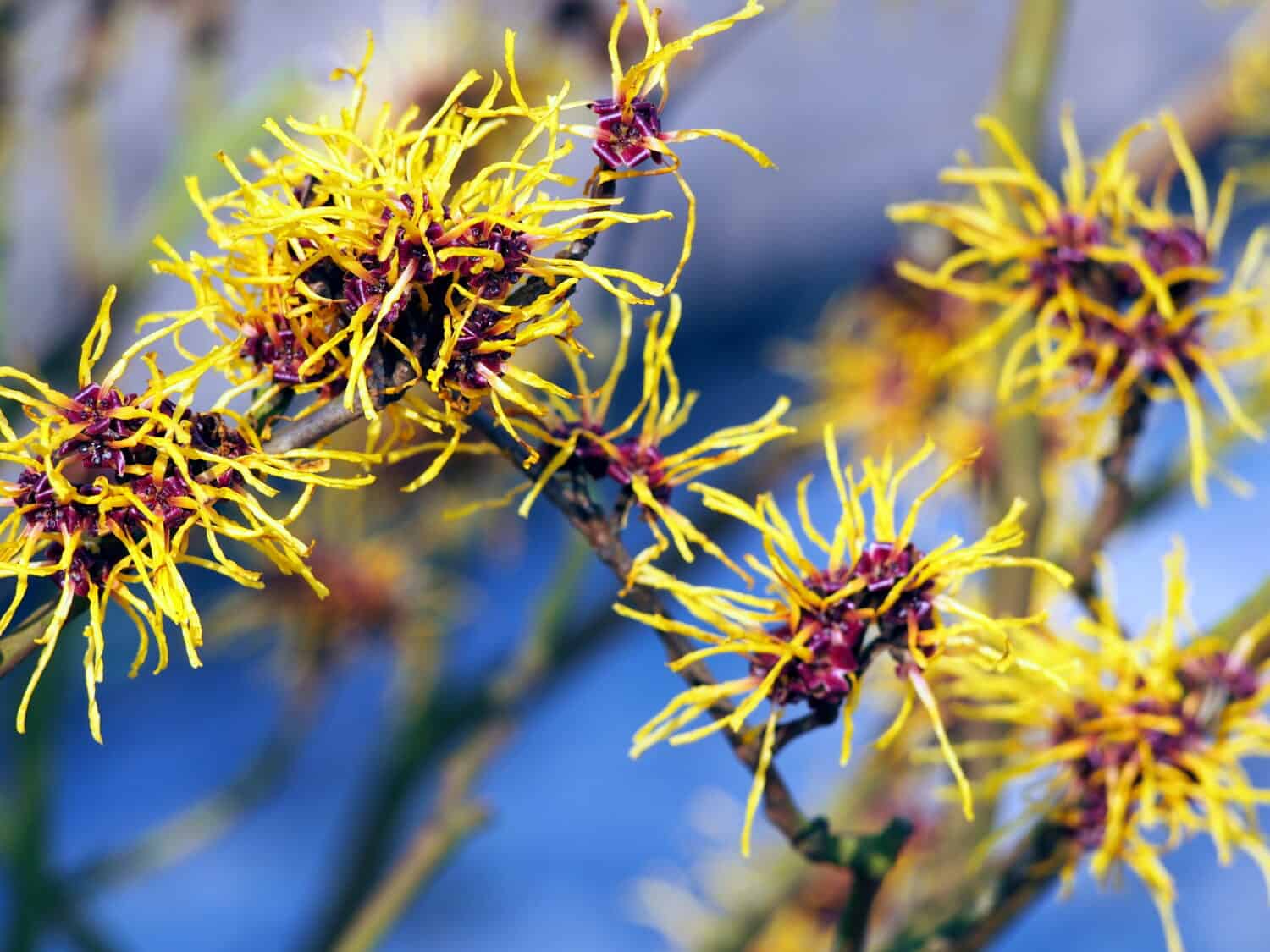
The witch hazel tree is maintenance-free and ignored by most pests.
©Anna Gratys/Shutterstock.com
This deciduous shrub, known for its remarkable winter-blooming habit, defies the usual dormant demeanor during the colder months.
In the midst of fall, the witch hazel bursts with its delicate, ribbon-like blossoms, which appear in shades of yellow, orange, or red. These blossoms hold a sweet fragrance and add a unique aesthetic to the landscape but also offer a respite from the winter chill with their unexpected presence and captivating scent.
Native to eastern North America, including Georgia, this small tree thrives in various soil types, including clay, loam, and sandy soils, as long as they are well-drained. Beyond its striking winter blooms, the witch hazel tree has been traditionally used for its medicinal properties. Native Americans and early settlers utilized its bark and leaves for various remedies.
Summary of the 22 Best Flowering Trees in Georgia
| Rank | Tree Type | Scientific Name | Height (feet) | Flowering Season |
|---|---|---|---|---|
| 1 | Flowering Dogwood | Cornus florida | 35-40 | Early spring |
| 2 | Cherry Blossom | Prunus serrulata | 15-30 | Spring |
| 3 | Southern Magnolia | Magnolia grandiflora | 60-80 | Late spring |
| 4 | Azaleas | Rhododendron spp. | 2-20 | Spring |
| 5 | Sweet Crabapple | Malus coronaria | 15-30 | Spring |
| 6 | Redbud Tree | Cercis canadensis | 20-30 | Early spring |
| 7 | Crape Myrtle | Lagerstroemia indica | 15-25 | Late spring |
| 8 | Sweet Bay Magnolia | Magnolia virginiana | 10-35 | Late spring |
| 9 | Scarlet Buckeye | Aesculus pavia | 10-20 | Early spring |
| 10 | Smoke Bush Tree | Cotinus coggygria | 10-15 | Late spring, early summer |
| 11 | American Fringe Tree | Chionanthus virginicus | 12-20 | Late spring |
| 12 | Chaste Tree | Vitex agnus-castus | 3-20 | Late spring, early summer |
| 13 | Carolina Silverbell | Halesia carolina | 30-40 | Early spring |
| 14 | Flowering Peach ‘Corinthian Pink’ | Prunus persica ‘Corinthian Rose‘ | 20-25 | Spring |
| 15 | Flowering Plum | Prunus spp. | 25-30 | Early spring |
| 16 | Raspberry Smoothie Rose of Sharon | Hibiscus syriacus ‘Raspberry Smoothie‘ | 8 | Summer |
| 17 | Tulip Poplar | Liriodendron tulipifera | 70-120 | Late spring, early summer |
| 18 | Serviceberry | Amelanchier spp. | 15-25 | Spring |
| 19 | American Yellowwood | Cladrastis kentukea | 30-50 | Late spring, early summer |
| 20 | Limelight Hardy Hydrangea Tea | Hydrangea paniculata ‘Limelight‘ | 6-10 | Summer |
| 21 | Purple Robe Locust Tree | Robinia pseudoacacia ‘Purple Robe‘ | 30-40 | Late spring, early summer |
| 22 | Witch Hazel Tree | Hamamelis virginiana | 20-30 | Fall, winter |
Thank you for reading! Have some feedback for us? Contact the AZ Animals editorial team.

